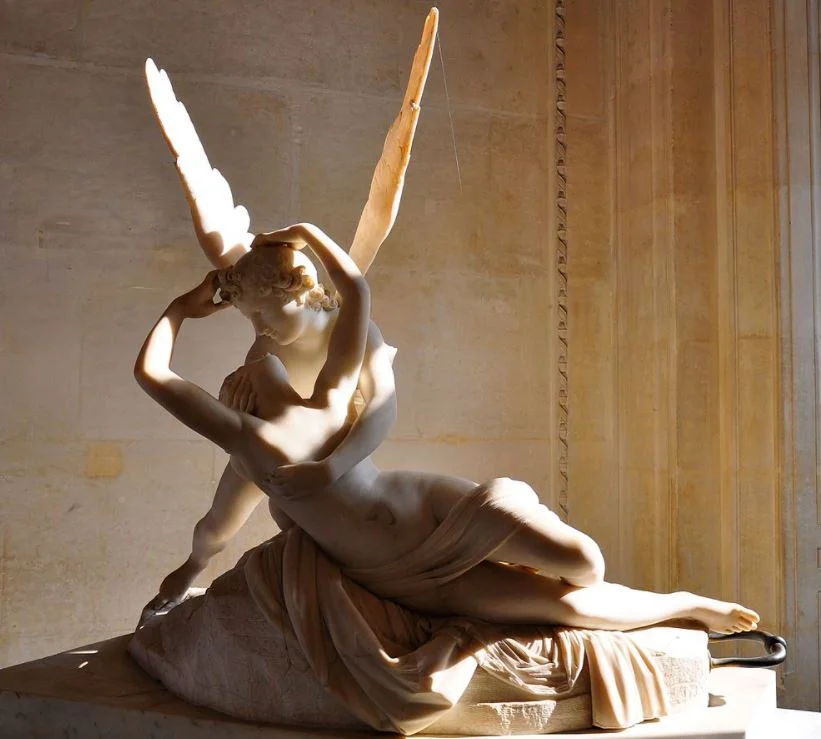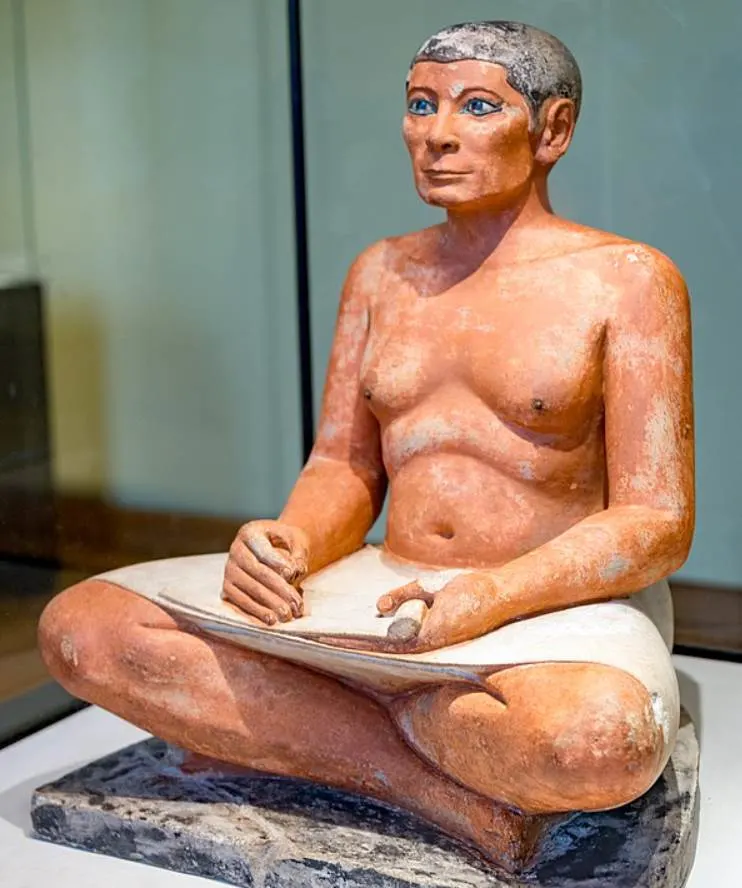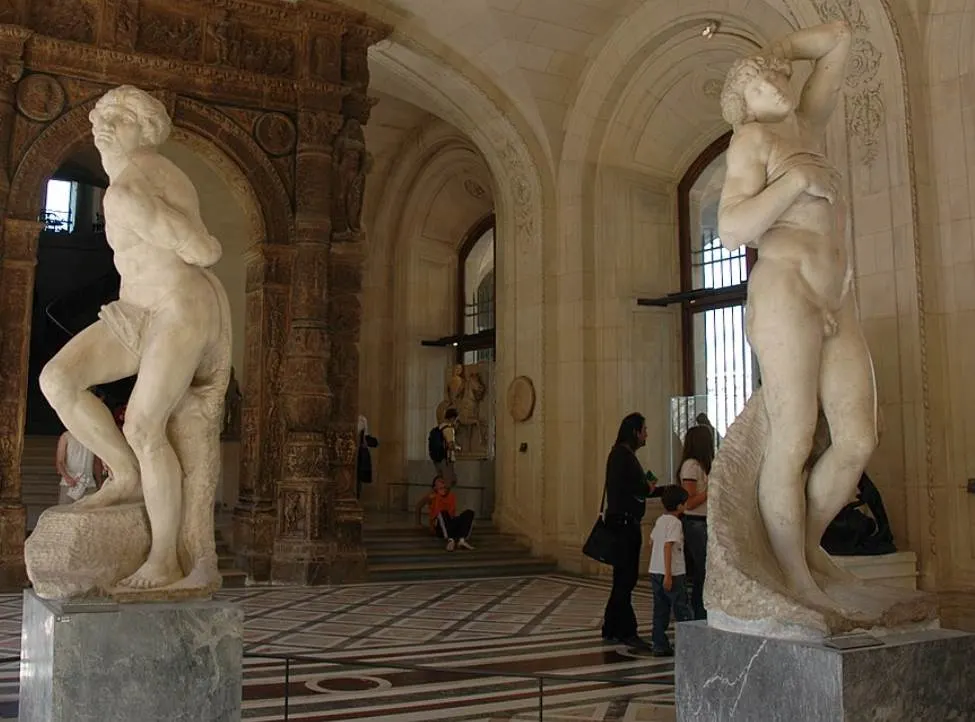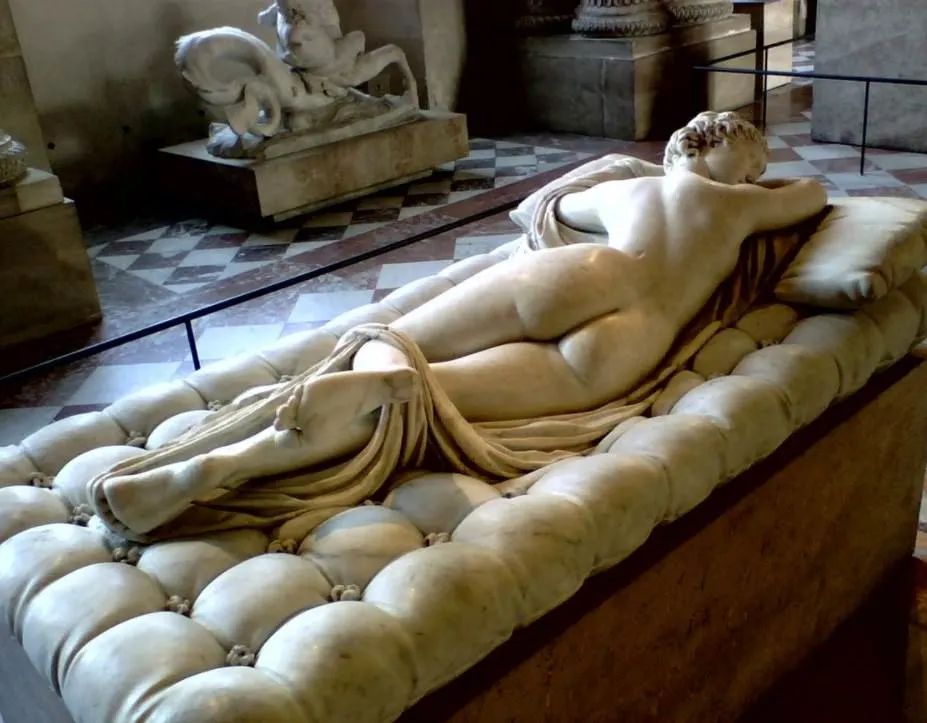Most visitors to the Louvre Museum in Paris are going there to admire the amazing collection of paintings.
The collection of paintings consists of over 7,500 works by over 1,400 artists who were born before 1900. This means it’s only a fraction of the museum’s collection of well over 600,000 items of which over 35,000 are on display.
The collection of sculptures at the Louvre was initially only small with only 100 works when the museum was established in 1793. It gradually grew and consists of thousands of sculptures and statues today.
In this article, you’ll discover some of the most famous sculptures that are on display at the Louvre Museum, both ancient and more recent works.
1. Venus de Milo – Alexandros of Antioch
- Date created: 150-125 B.C.
- Dimensions: 204 centimeters (6 feet 8 inches)
The Venus de Milo is one of the most famous sculptures at the Louvre and one of the best-recognized sculptures of ancient Greece.
It was produced during the Hellenistic Period, a period in which the Romans conquered the entire Greek world between 343 and 31 B.C.
The statue depicts Venus, the Roman name of a goddess referred to as Aphrodite in ancient Greece. The sculpture has both of its arms broken off but is in relatively good condition otherwise. It was only discovered in 1820 on the Greek island of Milos.

2. Psyche Revived by Cupid’s Kiss – Antonio Canova
- Date created: 1787–1793
- Dimensions: 155 × 168 centimeters (61 × 66 inches)
Psyche Revived by Cupid’s Kiss is one of the most famous sculptures by renowned Neoclassical artist and leading sculptor of his time Antonio Canova (1757-18822). It was commissioned by a Welsh art collector named Colonel John Campbell and the first version was completed in the early 1790s.
The Italian artist depicted Cupid, the god of love and desire, shortly after he awakened his lover Psyche with a kiss.

The story of the sculpture was derived from a Latin novel written by Lucius Apuleius’ in the 2nd century A.D. called “The Metamorphoses of Apuleius.”

3. Nymph of Fontainebleau – Benvenuto Cellini
- Date created: 1543
- Dimensions: 205 x 409 centimeters (80.7 x 161.02 inches)
The Nymph of Fontainebleau is a huge bronze relief and one of the best-known works by Benvenuto Cellini (1500-1571), the controversial Italian sculptor from Florence. It was produced when the artist worked at the court of the French king Francis I.
The relief was intended to decorate the entrance of the Palace of Fontainebleau, one of the largest palaces in France and an official residence of the French monarchs.
It never hung there and was instead moved to the Château d’Anet before becoming part of the collection at the Louvre. It can be found at the Mollien Staircase.

4. Winged Victory of Samothrace – Ancient Greek
- Date created: 200-190 B.C.
- Dimensions: 244 centimeters (96 inches)
The Winged Victory of Samothrace is another original ancient Greek sculpture. It’s another masterpiece of the Hellenistic period, although it has been severely damaged. It misses both arms and its head and the sculpture’s base takes on the form of a ship’s bow.
The sculpture was discovered in the year 1863 by French archaeologist Charles Champoiseau (1830-1909). He was excavating the remains of the Samothrace Temple Complex on the Greek island of the same name.
It’s one of the most famous sculptures at the Louvre and has been decorating the museum’s Grand Staircase since 1884.

5. The Seated Scribe – Ancient Egyptian
- Date created: 2450–2325 B.C. (5th Dynasty) or 2620–2500 B.C. (4th Dynasty)
- Dimensions: 53.7 × 44 × 35 centimeters (21.1 x 17 x 14 inches)
The Seated Scribe is one of the most fascinating sculptures at the Louvre from Ancient Egypt. The sculpture was discovered at Saqqara, the huge necropolis of the ancient Egyptian city of Memphis.
This area also features the step-pyramid of Djoser and is located about 30 kilometers (19 miles) south of Cairo.
The sculpture depicts a man in a seated position as he holds a roll of papyrus, a material that served as a writing surface in ancient Egypt. This limestone sculpture is remarkably well-preserved and the eyes were produced with magnesite and rock crystal.

6. The Slave Sculptures – Michelangelo
- Date created: 1513-1516
- Dimensions: 215 centimeters (7 feet 4 inches)
The Dying Slave is one of the sculptures by Michelangelo that he produced to decorate the Tomb of Pope Julius II. This tomb was intended to be placed inside St. Peter’s Basilica but it was eventually moved to the church of San Pietro in Vincoli.
The sculpture has a companion called “The rebellious Slave,” also part of the collection of the Louvre.
The tomb of the pope was never completed as Michelangelo intended and both slave statues weren’t included. Michelangelo Moses is the most famous work of the sculptural group.

7. Sleeping Hermaphroditus – Ancient / Gian Lorenzo Bernini
- Date created: Unknown / The Mattrass in 1620
- Dimensions: 169 centimeters (67 inches)
The Sleeping Hermaphroditus is an ancient sculpture that was produced at an unknown date. It depicts a figure from Greek mythology called Hermaphroditus who is lying on a mattress sculpted by Gian Lorenzo Bernini (1598-1680), the great Baroque master of the 17th century.
The ancient sculpture was discovered in the early 17th century near the church of Santa Maria della Vittoria, a Baroque building that features Bernini’s masterpiece “The Ecstasy of Saint Teresa.”
Cardinal Scipione Borghese placed it in his Villa Borghese but it was purchased by the French state and brought to Paris in 1807, along with multiple other works in the Borghese collection.

8. Great Sphinx of Tanis – Ancient Egyptian
- Date created: 20th – 26th century B.C.
- Dimensions: 183 x 154 x 480 centimeters (72 x 60.6 inches x 15.7 feet)
The Great Sphinx of Tanis is another marvel from Ancient Egypt that could potentially date back to the 26th century B.C. This granite sculpture was discovered in the ruins of the Temple of Amun-Ra in Tanis, an archaeological site in the northeastern part of the Nile Delta.
What’s remarkable is that this temple was only constructed between the 21st and 23rd Dynasties of ancient Egypt.
The sculpture itself was produced much earlier between the 4th and 12th Dynasties. It became part of the Louvre collection in 1826 and was only moved indoors in 1848.

9. Borghese Gladiator – Agasias of Ephesus
- Date created: 100 B.C.
- Dimensions: 199 centimeters (78 inches)
The Borghese Gladiator is an ancient sculpture that dates back to around 100 B.C. which was the Hellenistic period of ancient Greece. It was produced in the ancient Greek city of Ephesus. It was found south of Rome in Anzio and was added to the Borghese collection shortly after.
What’s remarkable is that the sculpture doesn’t depict a gladiator as its name suggests but a warrior.
Despite this misidentification, it became one of the most popular ancient sculptures in the 18th century and was reproduced multiple times. It’s another sculpture that was acquired by France in the early 19th century.

10. Diana of Versailles – Ancient Roman
- Date created: 1st – 2nd century A.D.
- Dimensions: 201 centimeters (79.13 inches)
Diana of Versailles is an ancient Roman sculpture produced in the 1st or 2nd century A.D. It depicts Diana, the Roman goddess of the hunt, and the sculpture was a reproduction and a slightly modified copy of an older bronze sculpture that was completed in the 4th century B.C. by Greek sculptor named Leochares.
It’s unclear where the sculpture was discovered but ut’s certain that it was given to King Henry II of France by Pope Paul IV in 1556. It was a reference to the king’s mistress named Diane de Poitiers (1500-1566).
It was moved to the Louvre Palace and eventually the Great Hall of Mirrors at the Palace of Versailles in the 17th century which is how it got its name. The “Diane Chasseresse” entered the collection of the Louvre in 1798 and has been one of the most remarkable attractions of the museum ever since.

